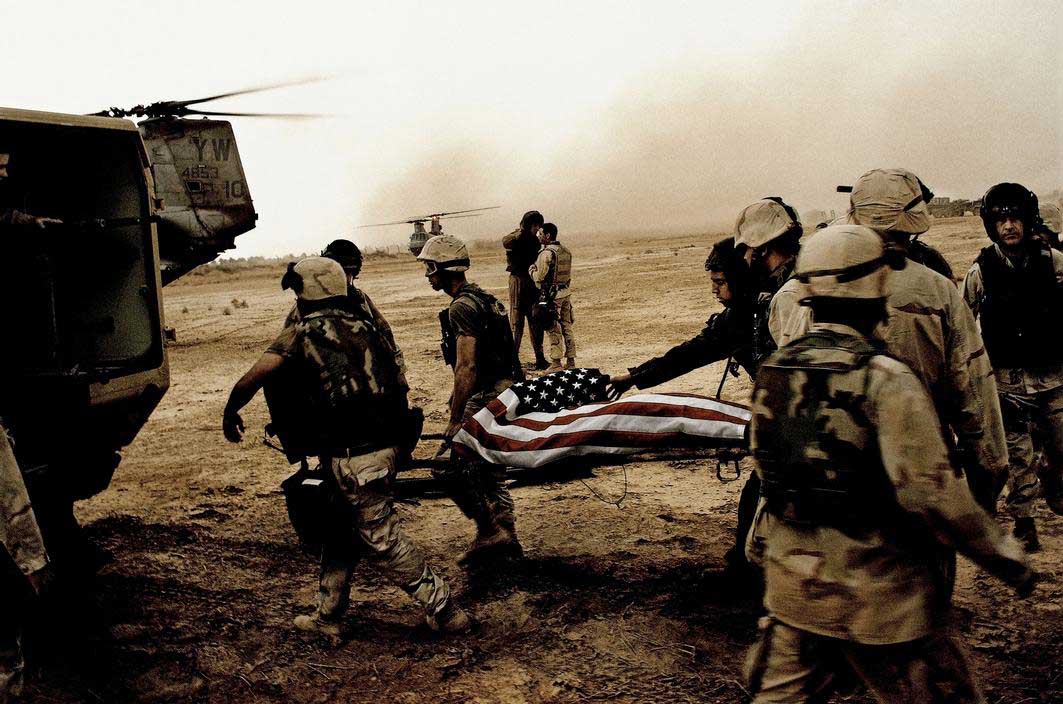Timothy Fadek, Mężczyzna płaczący nad workiem zawierającym resztki (czaszka, trochę kości i ubrania) kogoś z jego rodziny, które zostały wydobyte z masowego grobu z czasów czystek Saddama, Maj 2003.
I'll never forget how hot it was, above 110 F. I had been working in the sun for hours and was just about to sit down and rest when I heard a man crying. His cries were so loud and agonized that it stopped everyone in their tracks. The man had just identified the remains of someone in his family. Holding the bag containing the skull, bones and clothing, he climbed into a small bus. This was at the site of newly discovered mass graves in Al-Mahawil, a town about 80 miles south of Baghdad and adjacent to the ruins of ancient Babylon. 3,000 bodies had already been dug from the ground, the remains collected in plastic bags. Families were searching for items - identity cards, scraps of clothing and other clues - to help identify their loved ones, victims killed during the 1991 Shia revolt against Saddam Hussein's regime. Looking back, there's no doubt in my mind that the war was a tragic, catastrophic mistake. Yet, it's important to remember that Saddam Hussein did indeed rule by sheer terror and medieval brutality, and this photo is proof of that. Is Iraq better off without Saddam? Despite nearly 10 years of US occupation and continuing violence, many Iraqi's are not so sure and neither am I.
Artykuł
#historia #starszezwoje
I'll never forget how hot it was, above 110 F. I had been working in the sun for hours and was just about to sit down and rest when I heard a man crying. His cries were so loud and agonized that it stopped everyone in their tracks. The man had just identified the remains of someone in his family. Holding the bag containing the skull, bones and clothing, he climbed into a small bus. This was at the site of newly discovered mass graves in Al-Mahawil, a town about 80 miles south of Baghdad and adjacent to the ruins of ancient Babylon. 3,000 bodies had already been dug from the ground, the remains collected in plastic bags. Families were searching for items - identity cards, scraps of clothing and other clues - to help identify their loved ones, victims killed during the 1991 Shia revolt against Saddam Hussein's regime. Looking back, there's no doubt in my mind that the war was a tragic, catastrophic mistake. Yet, it's important to remember that Saddam Hussein did indeed rule by sheer terror and medieval brutality, and this photo is proof of that. Is Iraq better off without Saddam? Despite nearly 10 years of US occupation and continuing violence, many Iraqi's are not so sure and neither am I.
Artykuł
#historia #starszezwoje

mocna galeria
Piekło wojny, tutaj tym gorsze że rozgrywała się również na tle religijnym.
Mocny fotoreportaż, choć zawsze mnie wkurza w fotoreportażach wojennych tekst
"warning: some of the following images are graphic innature and might be disturbing to some viewers"
fotorelacje z wojen powinno się małolatom pod koniec szkoły średniej pokazywać, żeby wiedzieli z czym się wiąże wojna.
Przede wszystkim z ludzkim cierpieniem.
No, ale przyszły żołnierz nie ma myśleć ani tym bardziej mieć jakiekolwiek wątpliwości.
Zaloguj się aby komentować
